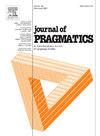Gender variability in the prosodic production of compliments in Italian: A pilot study
IF 1.7
1区 文学
0 LANGUAGE & LINGUISTICS
引用次数: 0
Abstract
The aim of this research is to examine the prosody of Italian compliments. Previous research on compliments has devoted minimal attention to the prosodic aspect of these expressions, and little attention has been addressed to the question of compliments in Italian. However, issues regarding intonation and duration seem to be of pivotal importance in the construction of compliments and in the differentiation of compliment responses.
To this end, a corpus of oral Discourse Completion Tasks (DCT) was analysed to describe a contextual situation in which speakers were required to offer a compliment. Eight Italian participants (4 men and 4 women) were asked to read the DCTs and provide an appropriate response to the given scenario. The comparisons were made between male and female participants, without considering cross-gender compliments. There were notable differences in the lexical and intonation preferences of the female and male participants. Acoustic analysis revealed evidence of gender-based differences in the prosody of compliments, specifically in terms of pitch range and duration. In particular, male participants showed a wider pitch range and longer stressed nuclear vowels than their female counterparts. These findings suggest a correlation between the prosodic strategies observed and the lexical choices present in the compliments. The data indicated that men used longer compliments with low lexical density and a greater number of implicit expressions, whereas women produced shorter compliments with a higher semantic density than those produced by their male counterparts. This was due to the higher incidence of intensifiers and positive words used by women. These features increased the number of high-pitched accents in the intonation contours of women's utterances, as well as the global pitch range, resulting in more expressive and affective compliments compared to those of men. This study broadens our understanding of Italian compliments by examining them from both lexical and prosodic perspectives. By addressing the lack of research on the prosody of compliments—particularly within the underexplored context of Italian discourse—it makes a valuable contribution to the field of pragmatics.
意大利语中赞美语韵律产生的性别差异:一项初步研究
这项研究的目的是研究意大利语赞美语的韵律。以往关于赞美的研究很少关注这些表达的韵律方面,很少关注意大利语中的赞美问题。然而,语调和持续时间问题似乎在恭维语的构建和恭维语反应的区分中起着至关重要的作用。为此,我们分析了一个口头话语完成任务语料库,以描述说话者被要求提供赞美的语境情况。8名意大利参与者(4男4女)被要求阅读dct,并对给定的场景做出适当的反应。这些比较是在男性和女性参与者之间进行的,没有考虑到跨性别的赞美。女性和男性在词汇和语调偏好上存在显著差异。声学分析揭示了赞美的韵律存在性别差异的证据,特别是在音高范围和持续时间方面。特别是,男性参与者比女性参与者表现出更宽的音域和更长的重音元音。这些发现表明,所观察到的韵律策略与赞美词中的词汇选择之间存在相关性。数据表明,男性的赞美语较长,词汇密度低,含蓄表达较多,而女性的赞美语较短,语义密度高于男性。这是由于女性使用强化词和积极词汇的频率更高。这些特征增加了女性说话的语调轮廓中高音的数量,以及全球音高范围,因此与男性相比,女性的赞美更具表现力和情感。本研究从词汇和韵律两个方面对意大利语的恭维语进行了考察,拓宽了我们对其的理解。通过解决对恭维语韵律研究的不足,特别是在意大利语篇的未充分开发的背景下,它对语用学领域做出了宝贵的贡献。
本文章由计算机程序翻译,如有差异,请以英文原文为准。
求助全文
约1分钟内获得全文
求助全文
来源期刊

Journal of Pragmatics
Multiple-
CiteScore
3.90
自引率
18.80%
发文量
219
期刊介绍:
Since 1977, the Journal of Pragmatics has provided a forum for bringing together a wide range of research in pragmatics, including cognitive pragmatics, corpus pragmatics, experimental pragmatics, historical pragmatics, interpersonal pragmatics, multimodal pragmatics, sociopragmatics, theoretical pragmatics and related fields. Our aim is to publish innovative pragmatic scholarship from all perspectives, which contributes to theories of how speakers produce and interpret language in different contexts drawing on attested data from a wide range of languages/cultures in different parts of the world. The Journal of Pragmatics also encourages work that uses attested language data to explore the relationship between pragmatics and neighbouring research areas such as semantics, discourse analysis, conversation analysis and ethnomethodology, interactional linguistics, sociolinguistics, linguistic anthropology, media studies, psychology, sociology, and the philosophy of language. Alongside full-length articles, discussion notes and book reviews, the journal welcomes proposals for high quality special issues in all areas of pragmatics which make a significant contribution to a topical or developing area at the cutting-edge of research.
 求助内容:
求助内容: 应助结果提醒方式:
应助结果提醒方式:


